|
Installation and Drivers
The card featured
in this review is not commercially available - I
got sent the card directly from NVidia, which do
make some graphics cards - mostly for reviews and
trade shows etc... but they don't actually sell
them in the shops. Instead, they sell the
components to other companies (Creative,
Guillemot, Visiontek...) who then build and sell
boards based on NVidia's core technology.
Because of this,
you'll get a different set of drivers for most
cards. However, NVidia have designed their own
"Unified Driver Architecture" in the
form of the Detonator drivers. These can be
downloaded from the NVidia site, and will work for
all graphics cards using their chipsets. It is the
latest Detonator 29.42 (WinXP) drivers that have
been used for the graphics card in this review. If
you do buy a GeForce 4 it is probably best to
stick with the manufacturers specific drivers.
Installation was
fairly hassle-free, once you've stuck one AGP
graphics card in you've done them all really.
Obviously, if you've not messed with the insides
of your PC before then you'll need to pay
attention to the product manuals.
Setting up the
drivers is as simple as running the installation
program, and the drivers do tend to be fairly
bullet-proof. Before now I owned a GeForce 256
for 2 years - using the Detonator drivers and very
rarely managed to crash the system (except for
when I messed up some code!). In writing this
review I did have lots of problems getting the
card to work properly with a couple of programs,
however an updated motherboard driver seemed to
fix the problem. With this in mind it is possible
that the drivers are not yet perfect for the
GeForce 4 Ti series, but given my personal
experience for the last two years (and online
opinion) I would say that this is an exception.
Benchmarks
3DMark2001 is the
standard program used to stretch a 3D card and
find out just how well it performs, it also gives
us some useful information regarding individual
features/test results which can be particularly
useful for programmers to know.
Given last months
review of the Radeon8500 the following tables
include the results listed in that review, the
Radeon8500 and GeForce Ti---- series are competing
for the crown, so it would make sense. I've also
included the results from my older GeForce 256
card - from the outset this does not stand a
chance of competing with the newer generation
cards, but the comparison is useful given that
many people will still be using GeForce 1 & 2
level cards.
Test system:
Gigabyte
GA-7ZM Via KT133 motherboard
700mhz AMD Athlon (Thunderbird Variation)
288mb PC100 RAM
15.3gb 7200rpm Maxtor DiamondMax +40 Hard drive
Microsoft Windows XP Professional Edition
Overall
score:
| Test
Resolution |
GeForce
256 |
Radeon
8500le |
GeForce
4 Ti4200 |
| 640x480,
32bit |
2860 |
5107 |
5813 |
| 1024x768,
32bit |
2440 |
4725 |
5383 |
As you can see,
the GeForce 4 Ti4200 already has an impressive 658
point lead over the Radeon. The following table
summarizes the individual tests results -
which are far more telling than the overall
scores.
1024x768x32
| Test
Name |
GeForce
256 |
Radeon
8500le |
GeForce
4 Ti4200 |
| Car
Chase [low detail] |
42.8
fps |
59.3
fps |
68.1
fps |
| Car
Chase [high detail] |
12.8
fps |
17.2
fps |
18.3
fps |
| Dragothic
[low detail] |
45.3
fps |
94.9
fps |
116.0
fps |
| Dragothic
[high detail] |
20.3
fps |
48.5
fps |
62.2
fps |
| Lobby
[low detail] |
46.8
fps |
62.6
fps |
67.3
fps |
| Lobbly
[high detail] |
21.6
fps |
26.3
fps |
27.6
fps |
| Nature
scene |
--- |
35.9
fps |
35.4
fps |
| Fill
Rate [single] |
229.4
MTexels/s |
770.3
MTexels/s |
846.7
MTexels/s |
| Fill
Rate [multi] |
427.6
MTexels/s |
1652.4
MTexels/s |
1895.8
MTexels/s |
| High
poly [1 light] |
8.7
MTriangles/s |
26.1
MTriangles/s |
28.1
MTriangles/s |
| High
poly [8 lights] |
1.7
MTriangles/s |
8.8
MTriangles/s |
8.8
MTriangles/s |
| Env.
Bump mapping |
--- |
97.9
fps |
103.6
fps |
| Dot3
Bump Mapping |
35.9
fps |
78.2
fps |
115.5
fps |
| Vertex
Shader |
22.7
fps |
57.8
fps |
55.9
fps |
| Pixel
Shaders |
--- |
72.7
fps |
85.2
fps |
| Adv.
pixel shaders |
--- |
58.2
fps |
70.7
fps |
| Point
Sprites |
6.6
MSprites/s |
25.0
MSprites/s |
25.1
MSprites/s |
note:
The 640x480x32 data followed the same trends, so
to save space I left it out.
There are three
key areas to look at in the above results:
1. Transform
& Lighting / Geometry Throughput
This is a measure of how much raw geometry can be
rendered every second, the higher this value the
more detail you can fit into your gaming
environments: Higher detail character models
and/or more objects/features. Interestingly the
Radeon 8500 and the GeForce 4 Ti4200 are almost
equal in this area. The Radeon 8500 has a higher
vertex shader throughput while the Ti4200 has a
slightly higher triangle throughput for 1 light.
The differences are negligible, and probably won't
be noticed hugely in real-world gaming situations.
It is interesting mainly because the Ti4200 is
generally the faster card all-round (higher
overall score), and the transformation pipeline is
one of the most crucial parts of 3D rendering.
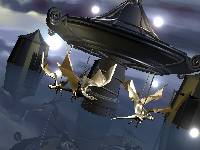
click to
enlarge
2. Fill Rate /
pixel shaders
Once geometry has been transformed it has to be
rendered to the screen as pixels (basic 3D
knowledge!), Therefore the overall speed of a
graphics card is heavily weighted towards
fill-rate performance, a card could have the most
amazing T&L system, but if the rasterizer
can't keep up, then it's never going to work well
(the same works vice-versa). It is this area where
the Ti4200 makes up any lost time when competing
with the Radeon 8500; Fill rate for
multi-texturing (the most common form in today's
games) is significantly higher (15%). Pixel
shaders are the latest technology in this area -
the programmable unit executed to determine the
final color of the pixel rendered. Games are
increasingly going to be using this technology (as
will you if you own/buy one of these cards), so
performance in this area is crucial. Luckily for
the Ti4200 it wins quite easily in this area -
with a 12.5 fps increase in both tests.

click to
enlarge
3. Overall
Game Performance
The first 7 tests listed above indicate real-world
performance in various types of game. This in many
respects is far more useful to know about than any
of the individual tests - the card may be capable
of a 1.9 gigatexel throughput, but if that doesn't
translate into good playable frame rates then its
not important. Also, when you put physics and AI
into the mix the work that the computer has to do
as a whole increases significantly. In all but the
nature scene the Ti4200 is faster (albeit only a
marginal performance increase). The score for the
nature scene is interesting as it is essentially a
game test heavily using vertex and pixel shaders;
which the Ti4200 does perform quite well (looking
at individual tests), yet in the real-world the
Radeon 8500 is equal to, or slightly faster than
the Ti4200.
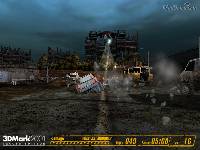
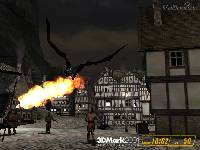
click to
enlarge
click to enlarge
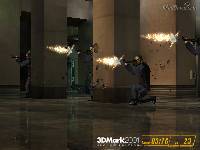
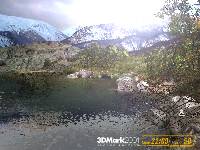
click to
enlarge
click to enlarge
Programming
Programming through Direct3D8 isn't really any
different between the Radeon 8500 and the Ti4200 -
this is the whole point of having API's such as
D3D8 and OpenGL, they abstract the interface to
the hardware. The only difference is in the
features/functionality that is available.
When comparing
the Radeon 8500 and the Ti series (note, the
features are the same for the 4200/4400/4600)
there are two important differences. Firstly, the
Radeon 8500 has a higher specification pixel
shader - version 1.4 (the highest possible under
D3D8.1) whereas the Ti series only has version 1.3
available (both have version 1.1 vertex shaders).
This will only cause you (as a developer) a
problem when it comes to writing cutting-edge
graphics engines, for the majority of people who
want to use some shader tricks version 1.3 will be
acceptable. In the long term (with D3D9 in mind)
version 1.4 may well be a better move. The second
difference is that the Radeon 8500 has an on-chip
tessellator therefore supporting N-Patches
(exposed as TruForm) should you want to use them.
Either the Ti series doesn't have an on chip
tessellator or it's disabled by the drivers
because it has no support for any form of patches.
This is probably of little concern to most people
- patches have been around for quite a while, and
it doesn't seem that many people are using them
extensively (even though they can be very useful!)
- whilst the Radeon 8500 is ahead here it still
has very limited patch support.
The GeForce 4 Ti
series has a few small features where it strides
ahead of the Radeon in features - most of them are
noticable only as extensions to older technology.
For example, the cards support 4096x4096 textures
in hardware (the Radeon could only handle
2048x2048) - why anyone would really want to use
such a huge texture is limited, given that a 32bit
version would be a whopping 64mb of video/system
memory (the total on the Ti4200 reviewed here).
I've uploaded a
print-out from the DxCaps program included with
the DirectX SDK, which gives the complete details
for the graphics cards capabilities. Should you
wish to examine this more closely, or check for a
specific feature you can read it here.
Programming using
a GeForce 4 Ti card is only really possible if you
have support/resources from NVidia, and any
special tools. This crosses into the area of
Developer Relations, which I shall discuss on the
next page...
Click
here to
go straight to the next page...
Or
select a page from the list:
• Introduction
• Installation, Benchmarks and Programming
• NVidia's Developer
Relations, Conclusion
|

